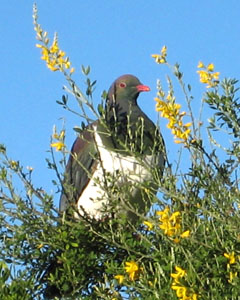Native New Zealand Birds: Tui and Kereru
New Zealand's long separation from any other land mass has resulted in a relatively small number of land birds. The primitive birds – the flightless moas and their relatives, the kiwis – probably arrived here by land before the drifting of the continents broke up the great land mass of Gondwanaland. The islands composing present day New Zealand drifted away and were cut off from the rest of the world about 80 million years ago. These ancient creatures survived for so long because of the absence of predators until humans arrived on the scene.
The birds in New Zealand are represented by about 248 species either breeding or known to have bred since the arrival of Europeans. Thirty-four species have been introduced by people and about forty regular and occasional visitors have been recorded. There are unique flightless birds in New Zealand such as the weka and takahe. A number of flying birds endemic to New Zealand belong to families which have no close relatives elsewhere in the world.

New Zealand Pigeon
The New Zealand Pigeon (hemiphaga novaeseelandiae) is one of the four species of of pigeons found in New Zealand. Its Maori name is Kereru. It is the largest species growing up to 51 cm and is native to New Zealand.
The Kereru is a plump and richly colored bird with a purple head and nape. It has a iridescent green face, throat and breast and lower back and a distinctive white 'bib' or underparts. You can hear the whoosh of its wings when it flies overhead. It is usually found in forested areas, feeding on young leaves, fruits and flowers of many native and exotic trees and shrubs.
It builds flimsy nests of twigs and sticks in the shrubs, trees and palms. The breeding period is between September to March. It lays one white egg each season and has an incubation period of thirty days.
It is easy to spot during the spring season when it feeds on young leaves and flowers. Sometimes they are seen on electric wires in the suburbs where there is a lot of greenery or big gardens.
The kereru like the tui or parson bird is an important seed disperser and disperses the seeds of 15 large tree species and is important for the health of the forests in New Zealand.

- TerraNature | Tui - Fruit-eating bird
New Zealand ecology - Fruit-eating birds, tui, Prosthemadera novaeseelandiae, check it out for more details and great photos.
Tui or Parson Bird
The Tui (prosthamadera novaeseelandiae) also called parson bird, is a member of the honey-eating (Meliphagidae) family found in Indonesia, Australia, New Zealand and the south-west Pacific (also Hawaii). It is known as the parson bird because of two tufts of white feathers on its throat.
The tui is widely distributed in forest areas throughout New Zealand and also in scrub, parks and gardens. It about 30 cm long, coloured metallic green, purplish black and reddishbrown, and with a double white throat-tuft, lacy white collar on back and sides of neck and white wing bars. The female is 29 cm and has a smaller throat-tuft and paler reddish brown abdomen.
The tui feeds on insects, fruits and nectar and can be seen hanging upside down from the branches of the kowhai tree, a native tree with yellow flowers. Although the tui's song resembles the bellbird, the richer notes are more fluid and resonant and can vary from district to district. They intersperse harsher, comic and imitative notes among the fluid notes.
The tui builds a bulky nest of sticks, moss and grasses about 3 to 15 meters off the ground. It often lays a double brood of two to four white or pale pink, speckled eggs between November and January. The incubation period is 14 days and while the female incubates the male sings from a nearby tree.
Both the kereru and the tui are essential for the ecological balance of New Zealand. Their habitat must be protected.








